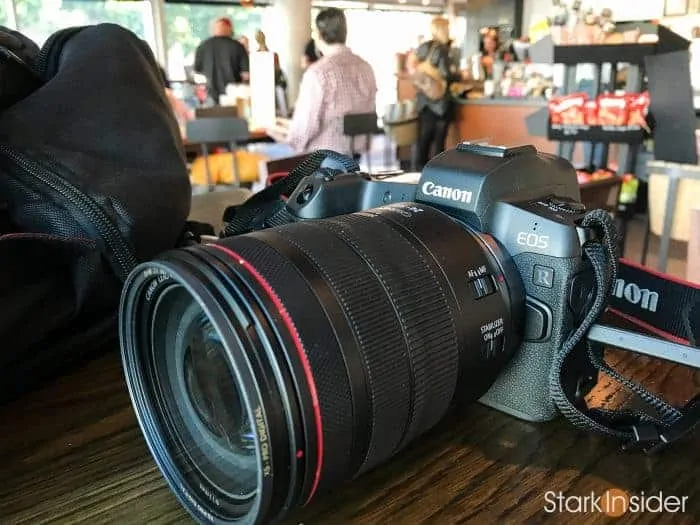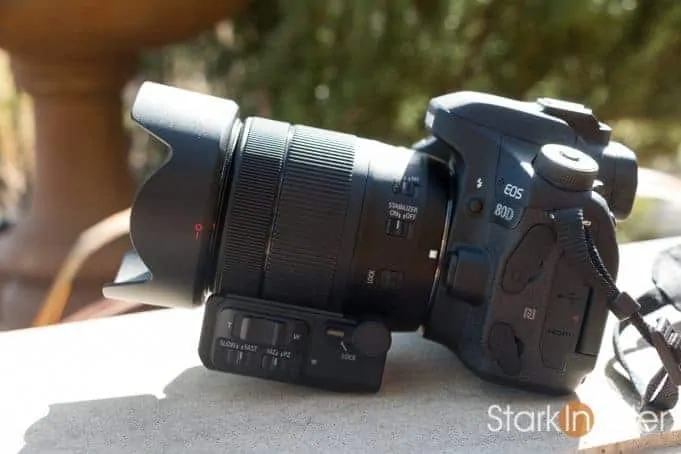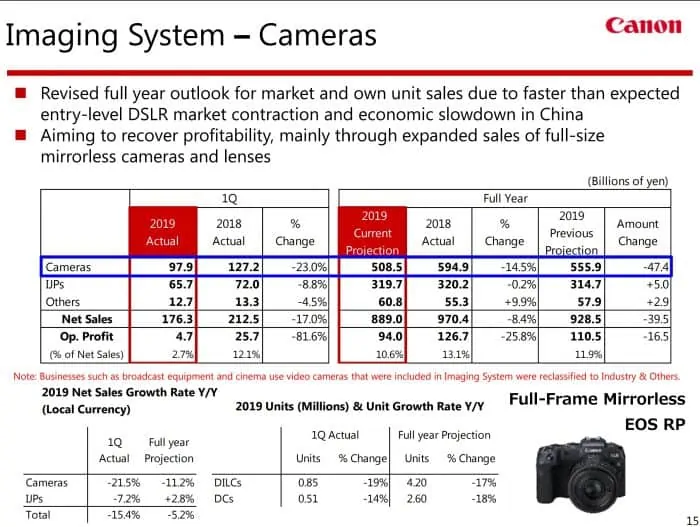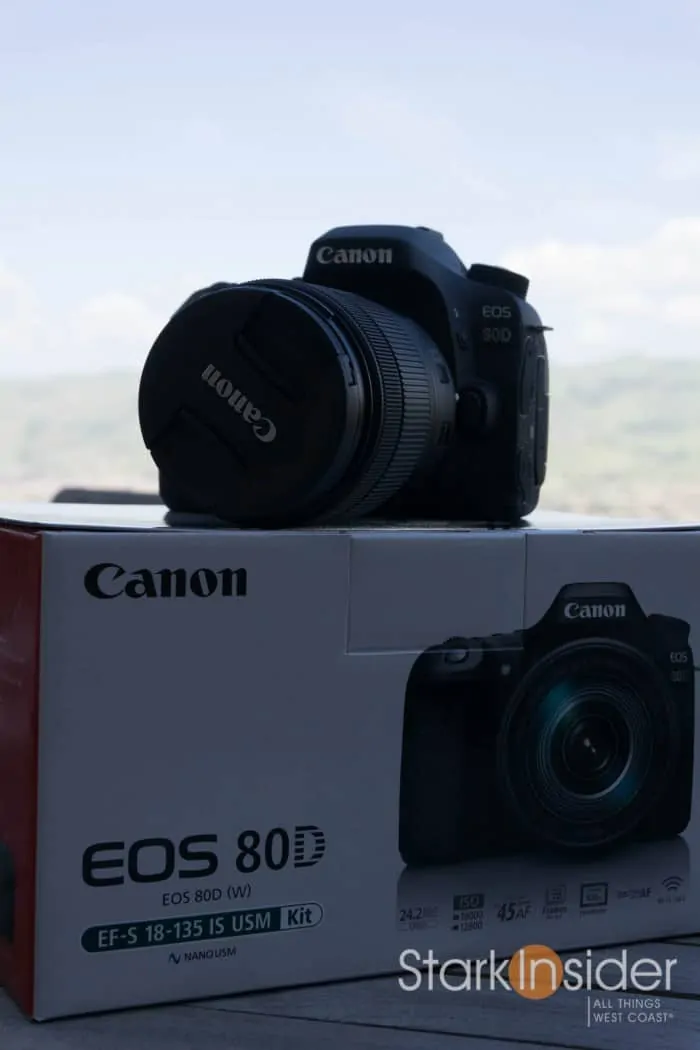Tough times these days for camera makers. After all, our phones do a pretty good — in some cases phenomenal — job of capturing high quality stills and video. Given that iPhones and Androids are always with us, in our pockets and purses, and are so easy to use, why bother with a dedicated DSLR or mirrorless camera at all?
Financial data out of Canon seems to be supporting that hypothesis. Sales numbers are ugly for Q1 2019. That’s not entirely surprising however. We’ve seen the rapid decline of the entry DSLR market (again, look to the smartphone as enemy #1) and now my belief is the enthusiast and $1,000-2,000 camera market is starting to take a hit as well.
Canon: Q1 2019 Summary
- Net Sales -10%
- Gross Profit -12.2%
- Operating Profit -47.6%
- Net Income -45.2%
Canon cites an economic slowdown in Europe and China and Euro depreciation for some of these woes.
Still, looking at those financials above the news looks pretty bad across the board. From what I can tell reading through the Q1 report (PDF), Canon breaks out its business into five units: Office; Imaging System; Medical System; Industry & Others; and Corporate & Eliminations. Because I’ve written about camera gear here on Stark Insider for the last 14 years or so, predominantly Canon, though most recently Panasonic (and the amazing GH5 mirrorless camera), I’m most interested in the Imaging System business which includes camera sales.
Slide 15 of the presentation dives into the Imaging System Cameras section.
Canon: Imaging System – Cameras
- Camera sales -23%
- Revised downward sales projection to $508.5 billion yen, -14.5% from previous projection
So far as I can tell we don’t know how well (or poorly) Canon’s new full-frame mirrorless cameras are performing. These include the new Canon EOS R and most recent entry model EOS RP. In addition Canon has introduced a new lens mount to market called RF, along with a series of (pricey) lenses.

However, Canon does say the “faster than expected entry-level DSLR market contraction” has contributed to poor camera sales. Focusing on higher end full-frame mirrorless models seems to be a key strategy to avoid further smartphone burn.
Specifically, Canon notes in its Q1 presentation:
“Aiming to recover profitability, mainly through expanded sales of full-size mirrorless cameras and lenses”
I expect that will mean fewer Rebel and lower priced Canon DSLR APS-C bodies in the future. And likely continued focus on the newer full-frame EOS R and RP and upcoming additions to its range.
Here’s hoping a successor to the EOS 80D — 90D? — doesn’t end up on the cutting room floor. The 80D is my all-time favorite Canon DSLR for shooting video. In 2017 that changed for us on Stark Insider with the release of Panasonic’s ground-breaking Lumix GH5. The GH5 does it all and I believe sold like gangbusters to the enthusiast and semi-pro (and pro) markets. I think Canon would do well to look to the GH5 when designing a potential EOS 90D.
Canon: Where Does it Go From Here?
I always believe when business gets tough one key focus point is simplification. Simplify product offering. Simplify pricing. Simplify distribution. Simplify value propositions. Does whatever you can to benefit from a slimmed down, easy to understand product portfolio. Eliminate weak sellers and those doomed to further erosion, in this case, from the smartphone.
Remember when Apple was struggling way back when (hard to imagine) under CEO Gil Amelio and others before him? Steve Jobs arrived back in style, took the reigns of the company and one of the first things he did aside from parking in a handicap spot was to simplify Apple’s product range into a basic quadrant. He placed a single Apple product into each, cut out the waste and confusion. Everyone marched in that direction. The rest is history. Over-simplification on my part here, of course, but the fundamental principles remain.
For Canon that might mean:
 Reducing its entry DSLR range to 1 or 2 key models — kill the rest
Reducing its entry DSLR range to 1 or 2 key models — kill the rest- Rapidly expanding its mirrorless full-frame range, including models targeted at video shooting enthusiasts (with the advent of YouTube and video everywhere this is very important in my estimation)
- Including more features in its cameras (worry less about cannibalization), but increase prices on upper end models — may sound counter-intuitive, but I believe camera manufacturers are moving up-market because, again, of the smartphone burn
Computational Photography: Software! Software! Software!
Here’s another thing to consider: computation photography. Or software.
Meaning, camera technology is increasingly about the smarts that drives the hardware itself. Yes, image sensors and lenses are still important (I don’t see how this will change in the foreseeable future), but software is the battleground of the here and now. This is a major weakness for companies like Canon, and also the rest of the traditional camera posse too like Panasonic, Nikon, Sony, and Fujifilm. Their pedigree is traditional imaging. And, unfortunately, clunky menus, ill conceived user experience design, and poorly written apps and software.
Then, along came companies like Apple and Google.
Their forte and pedigree? Software. User Experience. And, increasingly, computational photography.
So, for example, you can take a portrait photo on an iPhoto with a blurry background without needing a special 85mm telephoto lens because the software will do it all for you automatically. Not to mention, the iPhone will sharpen, over-contrast, and over-saturate your photos, making them wildly popular for gaining social media Likes (but not photography awards that’s for sure).
I believe the Canons, Sonys, Nikons and Panasonics among others need to bone up on software R&D. Cameras need to be far easier to use. Menus need to be modern and smartphone-like. Same goes with connectivity and the ability to easily share stuff online. Lest they all become dinosaurs this is where the world is headed and if they don’t invest here, time will pass them by.
Key point: famed film director Steven Soderbergh shoots all his new projects with iPhones. Films like Unsane and the new High Flying Bird (Netflix) are shot with minimal crews and an easy to use and handle iPhone. Will all films be shot with an iPhone in the future? I sure hope not (Hello Christopher Nolan!). Still, as these devices get better and better in large part thanks to computational photography and similar technologies, many will likely prefer to shoot with a convenient setup that doesn’t require massive and expensive and time-consuming rigging.
All this to say that the camera industry is at a major inflection point.
Canon needs to modernize its approach. What worked in the past — simply iterating basic feature and processor updates from one model to the next — is a dead end. That not only means a product revamp and simplification. But, I believe it also requires a cultural lightning strike. Having worked for a Japanese company (“Yes, you don’t.”), I know culture is deeply rooted and significant. I don’t pretend to know the prescription here for change, but I do know it’s likely akin to trying to rapidly turn a massive ship in a stormy ocean. It won’t be fun! Unless you’re a spectator, like me, watching and blogging from afar.




